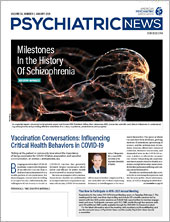One in three women and one in eight men among medical school faculty in the United States experienced gender harassment at work within the last year, according to a survey of more than 8,200 faculty members at 13 medical schools released by the American Association of Medical Colleges (AAMC). Yet only 54.6% of women and 67.6% of men who experienced harassment said they would feel safe reporting the incidents, and only 33.7% of women and 50.4% of men who experienced harassment said they felt confident that their medical school would resolve the incidents effectively.
These figures are testimony to a system of gender harassment reporting and intervention long in need of culture change, said Diana Lautenberger, M.A., director of Faculty and Staff Research and Women in Medicine and Science at AAMC.
“For too long, we’ve been in a situation where if someone comes forward, it’s their career that ends up being ruined more than that of the person who committed the harassment, which is unconscionable,” Lautenberger told Psychiatric News. “It creates a hostile environment where you don’t do your best work and you cannot be your most productive self if you know you have to deal with this behavior and feel there is no recourse.”
Lautenberger added that it is not only the victims whose performance and mental health are affected. “It takes a physical and emotional toll on bystanders who see it or overhear it as well.” Among women, 24.2% reported that someone had put them down or acted in a condescending way toward them because of their gender; 20.9% reported that someone told sexist stories or jokes that were offensive to them; and 12.9% reported hearing someone refer to women in offensive, insulting, or vulgar terms. Among men, the most common form of harassment was hearing sexist stories or jokes that were offensive to them, as reported by 10.5% of male respondents.
“We focus so much on the egregious that there is a disconnect so that people say ‘but I didn’t touch the person so it’s not harassment,’ ” Lautenberger said. “There is a spectrum that includes gender put-downs and offensive speech.”
People who experience harassment in medical schools fear reporting it for several reasons, said past APA President Renée Binder, M.D., a professor and director of the Psychiatry and Law Program and associate dean for Academic Affairs at the University of California, San Francisco School of Medicine.
“There is a fear of not being believed, and there is some embarrassment that other people might learn of it and think of them as a victim,” she said.
Binder added that there is also a fear of covert retaliation, a phenomenon she outlined with colleagues in the December 2018 issue of Academic Medicine. “They are worried that they will be up for a faculty position, grant, or award and that they will not get it because the person who harassed them is very powerful and may say something negative about them. If they don’t get it, they will always wonder if it was because of what the person said.”
Binder explained that when there is fierce competition for a job or grant, negative comments that seem casual and off the cuff such as “I heard there were issues about her in the past” could affect a candidate’s chances.
Creating Safety
Although there are usually policies for reporting harassment, creating a safe working and educational environment is a team effort where everyone must be prepared to intervene, said Binder. “It’s important for anyone who observes harassment to be able to say something about it,” she said. “When someone makes an inappropriate joke, you don’t laugh. You stop and take a step back because it’s not funny.”
She added that those giving offense should be given the benefit of the doubt, but should still be made aware of the impact of their behavior. “You can say, either in the moment or later on, ‘I’m sure you didn’t mean to say something that was sexist, but it came across that way.’ Most will apologize, but some will say that people are just too sensitive, and there should be consequences for that.”
Howard Y. Liu, M.D., M.B.A., president of the Association of Directors of Medical Student Education in Psychiatry and chair of the Department of Psychiatry at the University of Nebraska College of Medicine, said that culture change should flow in many directions and include students.
“Culture is influenced top down, horizontally, and bottom up. From the top, senior leaders in academic health centers have to monitor the learning environment reports actively and carefully investigate reports of gender harassment, and take decisive action against confirmed perpetrators,” Liu said. “From the bottom up, students have to feel empowered to report harassment and be given the confidence that their reports will be taken seriously and investigated without retribution.
“Horizontally, medical schools can implement programs that create safe spaces for reporting and engage students and faculty in dialogue about gender harassment,” Liu added. “Institutions cannot just ‘check the box’ by having faculty watch an online module and assume that the problem is addressed.”
Timothy R. B. Johnson, M.D., the Arthur F. Thurnau Professor and professor of obstetrics and gynecology at the University of Michigan, agreed. Johnson is a co-author of a study in the November 2020 issue of the Journal of Women’s Health that found that among 705 faculty members who had worked at the University of Michigan Medical School for at least one year, 82.2% of women and 64.9% of men had experienced gender harassment from staff, students, or faculty.
“Leadership has to care about [gender harassment] whether they are men or women. The dean and vice dean have to care about it. You can’t just appoint someone to a diversity and inclusion position and expect them to do all the work,” said Johnson, who is also a research professor at the university’s Center for Human Growth and Development. “You also have to give people training in how to recognize harassment, how to respond to it, and how to engage as a bystander when you see it.”
At the University of Michigan, students learn how to respond to harassment as part of their training, not only to protect themselves in the present, but also so they are not caught off-guard by it as they embark on their careers after medical school. Training involves role-playing, during which medical students learn what to say, what to do if they are harassed by a faculty member, and how to intervene as a bystander.
Johnson said that training for faculty needs to be ongoing. “We need to talk about it on a regular basis. It’s not just taking one training and forgetting about it.”
Binder reflected on the passage of Title IX, the federal civil rights law passed as part of the Education Amendments of 1972, which made it illegal for education programs that receive federal financial assistance to discriminate on the basis of sex. Title IX also forbids retaliation against anyone who makes charges, testifies, or participates in any complaint action under Title IX.
“Certainly there has been a culture change since 1972, and a change in the world and the United States since 1972,” Binder said. “But changing the law was the easier part. The harder part is changing people’s perceptions and behavior. It takes a while.” ■



